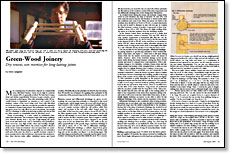
Synopsis: Drew Langsner says that successful joinery depends on attention to and control of the moisture content of the wood. The techniques used in working green wood not only allow for wood movement but also use it to advantage to make post-and-rung mortises and tenons that are often superior to comparable joints in kiln-dried wood. He discusses moisture content and differential shrinkage, how to build a post-and-rung stool, how to size dry tenons, and what moisture level the mortise stock should be before boring it. Side information details how to dry wood in a homemade kiln.
Most contemporary woodworkers depend on commercially sawn, kiln-dried lumber. Green wood, high in moisture content (MC), is generally avoided: We hear that it warps, twists and shrinks unpredictably. However, in past centuries, wood was commonly worked green, often with outstanding results. All successful joinery is dependent on attention to and control of the moisture content of the wood being used. Even with kiln-dried wood, it’s necessary to take into account the potential for expansion or contraction of parts being joined. The techniques used in working green wood not only allow for wood movement, but actually use it to advantage to make post-and-rung mortises and tenons that are often superior to comparable joints in kiln-dried wood.
“Green woodworking” is a term coined by ladderback chairmaker John Alexander. The techniques begin with riving (splitting) your material directly from a log and rough-shaping the green (wet) wood with hand tools, such as drawknives and spokeshaves. Riven wood has very high tensile, shear and bending strength, because each rived “billet” follows the natural, long fiber direction of the wood. “Green-wood joinery” does not mean joints are assembled wet; Final joint dimensioning and assembly are not undertaken until each of the parts has dried to a specific moisture content. A more accurate term is dry/wet joinery—dry tenons into moist mortises. Most dry/wet joints utilize cylindrical tenons and bored mortises. I’ll briefly discuss the principles involved in dry/wet joinery, then I’ll describe my techniques for applying these principles in the construction of the post-and-rung stool in the bottom photo on p. 63.
Moisture content and differential shrinkage—In green woodworking, the most important principle to remember is that wood is hygroscopic, which simply means the wood will absorb and release moisture with variations in environmental humidity. Freshly cut wood contains moisture within the cell cavities, called “free water”; and moisture in the cell walls, called “bound water.” As wood dries, it first loses free water, down to about 30% MC. This is the “fiber saturation point.” The cell cavities are empty, but the cell walls are still saturated. As wood dries, its dimensions remain stable until it reaches the fiber saturation point. Then it begins to shrink, check and warp as it loses bound water. Tangent to the growth rings, most woods can shrink from 10% to 15%, while on the ray plane (perpendicular to the growth rings), maximum shrinkage is only half as much, 5% to 7%. This is “differential shrinkage.” Because of differential shrinkage, a cylinder shaped from green wood will eventually dry into an oval cross section, with the oval’s long axis on the ray plane (see figure 1 on the facing page). Oak and other ring-porous hardwoods, commonly used by “green woodworkers,” are among the species that shrink the most.
From Fine Woodworking #77
For the full article, download the PDF below:
Fine Woodworking Recommended Products

Ridgid R4331 Planer

Suizan Japanese Pull Saw

Starrett 4" Double Square




















Log in or create an account to post a comment.
Sign up Log in